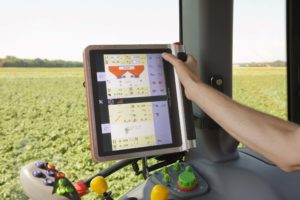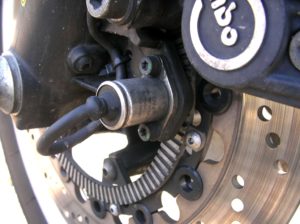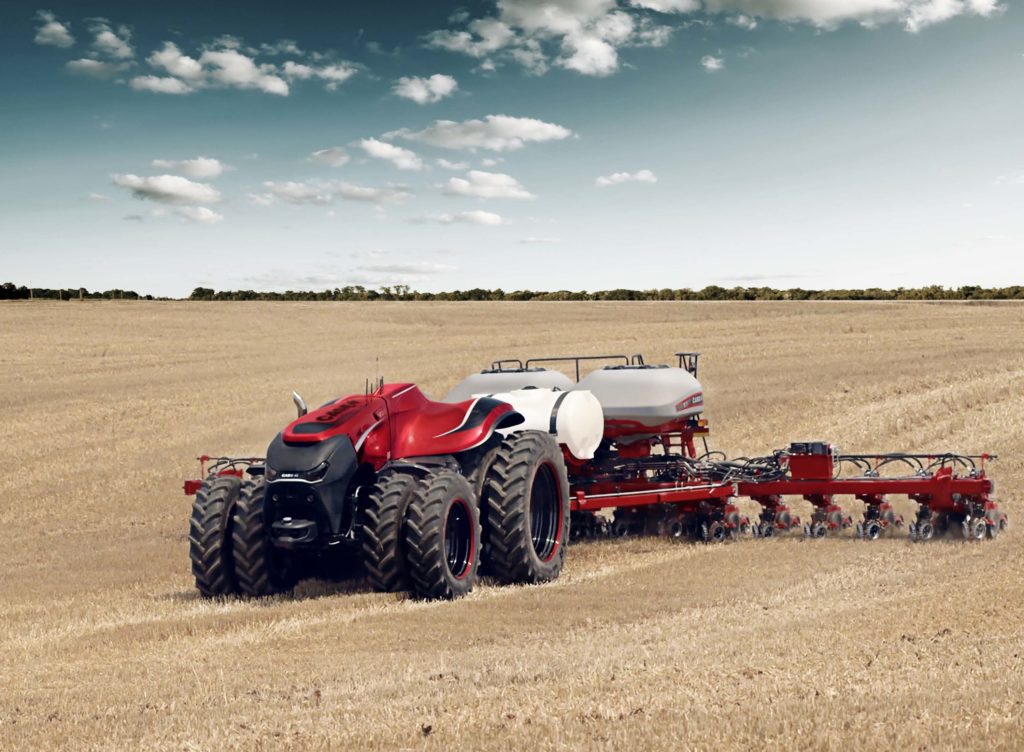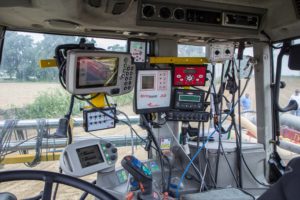Agriculture 4.0 is powerfully making its way into companies, also through accessories and components of tractors.
From animal drawn tractors to modern ones, the agriculture mechanization sector has seen a continuous technological development particularly over recent decades. The advent of electronics was a landmark that enabled the diffusion, at all levels, of devices able to check and adjust the functioning of all the component parts of the machinery in order to maximize the performance. The combination of electronics and precision mechanics enables, moreover, to improve the efficiency and sustainability of operations, and therefore, (as ripple effect) of the whole agricultural production. The selection of components and accessories is therefore of the utmost importance during the design phase of any device.
Electronics and Isobus
The electronic control systems allow to check and adjust real-time any component (from the engine to the lifter) in order to optimize the performance in accordance with specific requests. As for agricultural machinery sector, electronics was initially applied to the engine, where the control unit analyzed a range of data detected by sensors and improved the functioning of the engine itself not least because of the need to comply with pollutant emission parameters. From here, electronics went to check almost every single part of the tractor: transmission, lift, PTO, etc. These control units, however, need to be continuously monitored and possibly inspected by the operator through centralized controls. In the past every single sensor and every single control unit had to be connected with a single electric connection: a huge number of wires with obvious risk of damage due to the working conditions (water, temperature, vibrations) but also to chance events (animals etc.).

Fig. 1 Canbus system enables to check all the control units by a single terminal with a single serial digital connection line.
These cabling problems were subsequently settled by the adoption of Can-Bus, born at the end of the 80s of the last century in the automotive area. It is a single serial digital connection line to which all end users are wired, allowing the connection among all the electronic devices installed in the tractor, improving the reliability of communications, reducing the costs and enabling the introduction of new electronic features without rewiring all the tractor. The devices connected to a Can-Bus system must comply with a transmission protocol based on ISO standards that allows to increase communication with no data loss. However, at the beginning of 2000, a further problem arose: the diffusion of electronics on equipment. Every machine with electronic control system was equipped with a control terminal placed at the driving seat, so as to multiply the links and especially the space inside the cabin, or even the managing of the whole instrumentation. For this reason, the development of a common standard, that would enable the tractor terminals to dialogue also with equipment, had become urgent. The Isobus system gathered in a single graphic terminal all information concerning equipment independently of brand or model; the connection between wires and tractor is implemented through standard connectors, and the tool is immediately recognized by the management software. However, the advantages do not concern only operators, but also (and maybe principally) the constructors because Isobus is an “open” standard, it is possible to connect tractors and implements of different manufacturers, without any incompatibility. Moreover, the latest versions of Isobus (the so-called class 3) can even allow the implements to drive (at least partially) the tractor. An example: the pick-up baler that autonomously decelerates and stops the tractor when the bale is ready to be tied and unloaded, relieving in this way the operator of an extremely boring and repetitive work.

Fig. 2a
Fig 2 Thanks to Isobus devices, we moved from the use of different terminals for each equipment (left) to terminals able to interact with any manufacturer’s equipment (left).
[su_box title=”The hydraulic system” box_color=”#43634b”]Considering the complete lack of suspension devices to the wheels, it is common practice to install on tractors (even on older ones) a seat with suspension, able to reduce the operator seat vibration. The first seats of this type were equipped with mechanical suspension: a sturdy iron bent bar with a spring at the ends or simple parallelograms also equipped with an internal spring. The spring, adjustable in its compression by a lever, absorbs the vibration transmitted by the frame, thus reducing the total value. The most modern seats are usually equipped with hydraulic mechanical suspensions or pneumatic ones. In both cases the seat contains an operating parallelogram, able to adjust seat’s height. The difference between the two models lies in the cushioning system: in the first case it consists of a hydraulic cylinder, adjustable by a manual pomp. In terms of comfort, the top is the pneumatic seat: in this case there is an inner tube, with pressure adjustable by means of a button, able to minimize seat vibration. In all cases, it is however important that pressure or spring stiffness are adjusted based on the weight of the operator: an indicator of correct regulation is often present, it can indicate the kilos (the operator can adjust it from the ground according to his weight) or a color indicator (in this case the operator can adjust it from his sitting position, bringing the indicator to the green zone).[/su_box]
Faster with ABS
The entry into force of the Mother Regulation, provides for the mandatory ABS (Antilock Braking System) for the new type-approvals of agricultural tractors with design speed above 40 km/h. What is ABS? It is a device that prevents the wheels from locking up during braking, thus avoiding the typical wheel slippage, improving vehicle control and increasing braking distance. The ABS acts when the rotation speed of a wheel decreases considerably compared to other. Thanks to an encoder (that detects real-time wheel rotation) the control unit verifies constantly these data, and if one or more wheels lock while braking, it modulates the brake pressure (through the hydraulic circuit) improving the grip of the tyre. If the introduction of such a system in the tractor is relatively simple, it becomes particularly difficult to combine it with the braking system tractor/trailer. As for the hydraulic circuits, the current devices use adaptable valves that check the oil pressure in the braking system of every single wheel, ensuring at the same time, the necessary operation speed. It is interesting to underline that, contrary to what might be thought, ABS achieves a significant increase in braking safety when the trailer is not fully loaded; in fact, if the mass is reduced, the wheels of the towed equipment under braking will lock up causing dangerous skidding, especially in cornering. This situation is emphasized as a result of the typical brake adjustment of the trailers, that of course is always calibrated for fully loaded means.

Fig. 3 A sensor of the ABS system, that constantly detects the number of passing “teeth” and thus monitoring the wheel rotation speed.
Vibrations? No, thanks!
The suspension of the cab and of the front axle are recent innovations, introduced mainly on models for long road transport. The suspended front axle, in fact, drastically reduces the problem of pitch, that is the juddering when travelling at high speed that sometimes makes it difficult to control the vehicle. This happens especially when the rim and the tyre are not perfectly round: when the rolling frequency gets close to the resonant frequencies of the frame of the tractor (and this happens most of the time at a speed of 38-42 km/h), small bumps are dangerously accentuated and have a considerable impact on driving. In terms of engineering, the suspension of the front axle is very simple: the front axle is hinged to the frame of the tractor via one or two hydraulic cylinders. The hydraulic circuit serving these cylinders is equipped with one or more nitrogen accumulators that cushion the stem movement by varying the nitrogen tube volume. Actually, the different types of construction of this simple circuit can be much more complicated. The simplest models are based on two hydraulic cylinders, placed on the side of the tractor frame, that absorb oscillations, transmitting them to the oil, and then to the nitrogen accumulator that cushions and limits the impact of the vibration. For precision works it is possible to disconnect manually the suspension: in this case almost all the manufacturers provide for the full retraction of the cylinders, bringing the front axle into contact with the principal frame. This ensures better monitoring and greater stability of the tractor front. Some models use a single cylinder that can be placed on the side or centrally; in this last case, in order to improve the control accuracy of the single cylinder, also a wishbones device can be used. As for the latest technical innovation we find for example amortized axles with independent wheels. In this type, the front axle is divided in two independent semi-axles, with wheels connected to the tractor frame through an articulated parallelogram and the hydraulic jack of the suspension itself. This particular suspension typology leads to several improvements. The most evident is related to the steering angle: a traditional axle, even if it is suspended, is hinged on a single central point; in its normal tilting the wheel approaches the engine hood, inevitably reducing the steering angle. In order to avoid functional problems, the steering limit switches must be properly adjusted. Per evitare inconvenienti funzionali, si devono regolare opportunamente i finecorsa dello sterzo. Whereas the physical split into two parts of the axle allows an almost vertical excursion of the wheel, with a steering angle that does not change in all driving situations. Moreover, the suspension acts in four points, improving the stability of the tractor thanks to the hydropneumatic system, that acts as a “variable spring stiffness”, through modulation of oil pressure, thus creating an anti-roll movement opposing to the machine tipping. Some tractor manufacturers have experimented the use of pneumatic suspensions, very similar to those of the trucks. From an engineering point of view it is very similar to hydraulic suspensions with the only difference of better operating at low temperature (where oil viscosity considerably reduces the capacity to absorb vibration).
Davide Giordano





